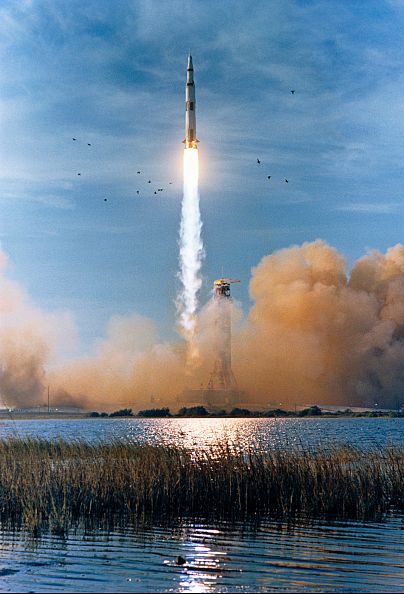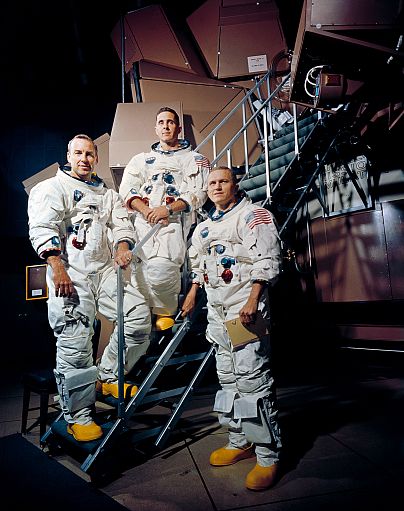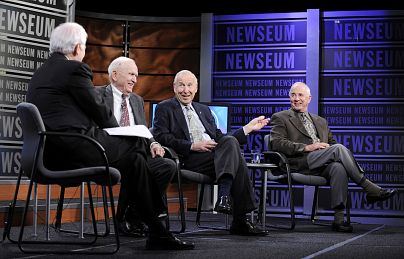The historic flight launched 50 years ago this week.
Anyone old enough to remember Apollo 11 has vivid recollections of Neil Armstrong taking those first steps on the moon, and even those born years after the celebrated 1969 mission know its place in history.
But Apollo 11 wasn't the first moon shot. That distinction belongs to Apollo 8, which launched into space 50 years ago this month. True, none of the Apollo 8 astronauts — Frank Borman, Jim Lovell and Bill Anders — walked on the moon. But their moon-circling flight yielded a trio of firsts: the first humans to venture beyond Earth's gravitational grip; the first humans to see the moon's far side; and the first time we saw our home planet as it really is — a tiny ball floating perilously in the vastness of space.
"In my view it is almost the equivalent, in its historical importance, of Apollo 11," said John Logsdon, author of "John F. Kennedy and the Race to the Moon" and other books on space exploration. "Apollo 8 demonstrated everything we needed to do to get to the moon, except the landing phase. I think that technically it was extremely important, and also in terms of public impact."
The mission came together with startling speed. The nation was still reeling from the tragic launch pad fire that killed the three astronauts aboard Apollo 1 in January 1967. But President Kennedy's 1961 pledge to land astronauts on the moon before the end of the decade had yet to be realized — and the Soviets were rumored to be preparing a manned lunar mission of their own.
So while it was originally conceived as another in a long string of Earth-orbiting missions, Apollo 8 became a moon mission. The massive, 36-story-tall Saturn V rocket needed for such a mission had been tested only twice and had never carried a crew. Borman, Lovell and Anders would be the first. They figured they had a 50-50 chance of coming home.
Moon-bound
Apollo 8 lifted off from Cape Kennedy (now Cape Canaveral) on the morning of Dec. 21. Less than three hours later came the go-ahead to leave Earth orbit for the moon: "You are go for TLI," mission control in Houston radioed the astronauts, using the acronym for "trans-lunar injection."
The astronauts fired the engine that would put them on a lunar trajectory, and from that point on, they were setting altitude records. Until then, the farthest that a human had been from Earth was 850 miles, during NASA's Gemini 11 mission two years earlier. Speed records also fell by the wayside, as the craft sped along at more than 24,000 miles per hour.
As Earth receded in the distance, Lovell described his view out the window: "I can see Florida, Cuba, Central America, the whole northern half of South America — in fact, all the way down to Argentina and down through Chile." No human had ever been able to see so much terrain in a single glance. Lovell would later note that, as they circled the moon, a quarter of a million miles from Earth, he could hide our entire planet behind his outstretched thumb.
Lucky shot
Anders was tasked with photographing the lunar surface in anticipation of an eventual landing. Taking snapshots of our home planet wasn't on his to-do list. But when Earth came into view after their third orbit of the moon, the crew looked out of the capsule's tiny windows to behold an awesome sight.
Our home planet was beautiful, but it looked incredibly small and fragile against the blackness of space. As Anders, now 85, told the TODAY Show's Harry Smith for a story airing on Dec. 20, "When the Earth came up over the lunar horizon, that's when it really impressed me, as to how much more delicate the Earth was, and colorful. The moon was not colorful."
Anders loaded his camera with color film, put on a telephoto lens and started shooting — worrying all the while that he might not get the shot he was looking for. "When I was in high school, I had a 35-millimeter camera with roll-up film in it, and actually tried to develop it a little bit myself, which was usually a failure," he told Smith. "But, you know, I knew the basics of f-stops and shutter speeds and that kind of thing. Could hardly call myself a photographer."
Photographer or not, Anders got several good shots. One in particular — one that came to be known as Earthrise — stood out. Life magazine named it one of the hundred most influential images in history. Nature photographer Galen Rowell described it as "the most influential environmental photograph ever taken." And in a series of widely quoted reflections after the mission, Anders famously said: "We came all this way to explore the moon, and the most important thing is that we discovered the Earth."
The photo became a national sensation. Within a year, Earthrise was on a U.S. postage stamp. In 1970 it became the symbol of the first Earth Day. "More than any single image, it helped underpin the environmental movement," Logsdon said.
The mission was also TV gold. Millions tuned in for the crew's broadcast on Christmas Eve, 1968. Asked only to deliver an "appropriate" message, the crew took turns reading from the Book of Genesis. They saw the reading as an acknowledgment of cosmic grandeur, though not everyone saw it that way. In 1971, an outspoken atheist named Madalyn Murray O'Hair sued the federal government for contravening the separation of church and state. The case was dismissed.
After completing 10 orbits of the moon, it was time for the crew to come home — assuming their small craft, and its engine, worked perfectly. "They were at that moment 'people of the moon,'" said Jeffrey Kluger, author of "Apollo 8: The Thrilling Story of the First Mission to the Moon". "They were within the moon's gravitational hold. And if that engine didn't re-ignite, they would forever be 'people of the moon.'"
But the engine fired successfully on the morning of Dec. 25, prompting Lovell to quip to Mission Control: "Please be informed there is a Santa Claus." Two days later, the astronauts splashed down safely in the Pacific Ocean, its once-white exterior blackened by the intense heat of reentry into the atmosphere. Seven months later, Armstrong and Buzz Aldrin left their bootprints on the moon.
The moon missions came to an end with Apollo 17 in 1972. But late last year, NASA pledged to return astronauts to the moon with the goal of establishing a long-term presence there. The agency, which is collaborating with other nations and with private companies, hopes to see a lunar-orbiting mission by 2023 and a landing by 2030.
Of course, no matter how routine moon missions eventually become, there can only be one first time. With Apollo 8, humanity took its first tentative steps beyond our home planet.














